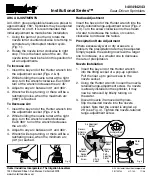
SDM-SIO1 Serial Input/Output Module
14
To avoid excess current wastage, the chip can be turned off when not in use, e.g.
between polled measurements, simply by closing the serial port, using Serialclose
(see below). When running in RS-232 mode with a sensor that only sends data
one-way to the datalogger, run the SDM-SIO1 in “receive only mode” as this does
not turn on the output drivers.
If using RS-232 mode also avoid connecting handshaking lines that are not
required to avoid the unnecessary 2 mA drain per line.
4
Programming the datalogger
The normal Serial port instructions such as SerialOpen and SerialIn are used with
the SDM-SIO1. Aside from changes to the COMport and the SerialOpenFormat
parameter a program written for a standard serial port will usually work with the
SDM-SIO1, providing the timing of the measurements is not very critical.
4.1 Special information about the Serial I/O CRBasic commands when
used with the SDM-SIO1
The following section gives further information about the CRBasic programming
language and how the serial commands are to be used with the SDM-SIO1.
This section assumes the user has knowledge of the CRBasic programming
language; if not then please contact Campbell Scientific for further assistance.
Only the parameters that need special explanation or where their functionality has
changed are listed below. Any other parameters should be taken as not having
changed. Please refer to the datalogger manual and/or the CRBasic help system
for more guidance.
4.1.1 SerialOpen
All internal buffers in the SDM-SIO1 will be flushed when this command is called
resulting in the loss of any data that might have been in them at that point in time.
COMPort parameter
The ‘COMPort’ numbers are defined in the ‘Address configuration’ section (see
Table 3.1). Comport numbers in the range of 32..47 are reserved for use with the
SDM-SIO1.
BaudRate parameter
Baud rate is used to set up the SDM-SIO1s baud rate as you would with any RS-
232 interface. The SDM-SIO1 does not support automatic baud rate recognition.
Instead setting the rate to a negative number sets the automatic flow control system
(RTS/CTS). This system is discussed in greater detail elsewhere in the document.















































